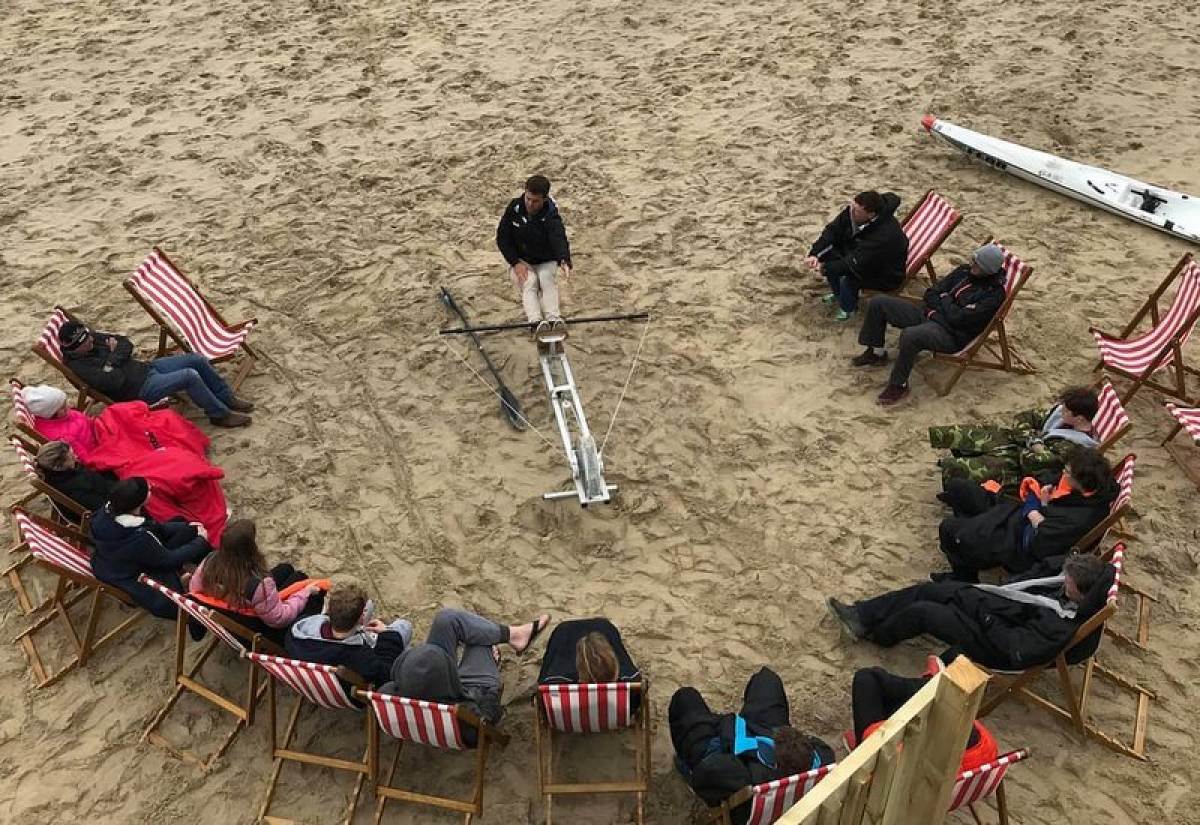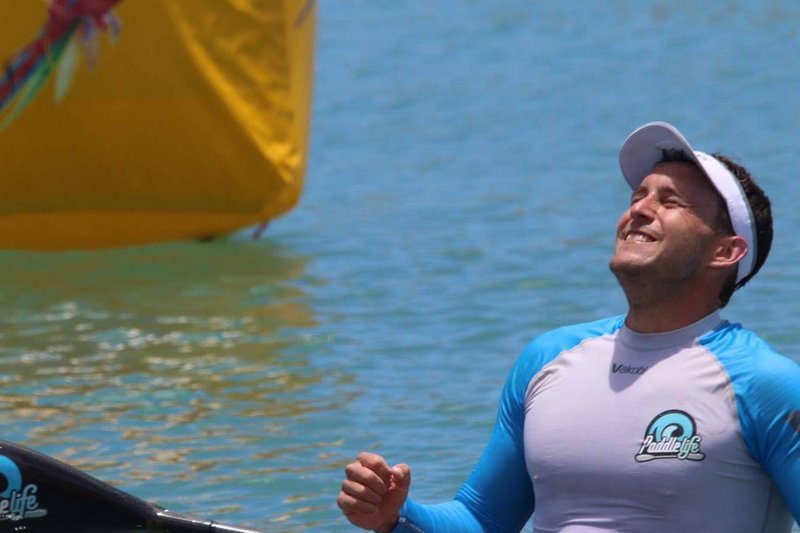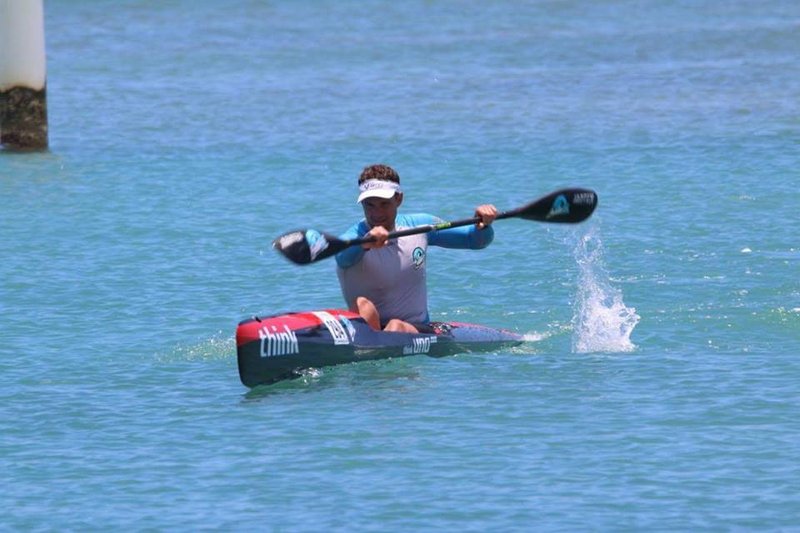Sean Rice Training Tips
 Sean Rice - coaching
Sean Rice - coaching
Sean Rice (2013 ICF Ocean Racing World Champion, 2017 Molokai Challenge Champion plus a host of other titles) of PaddleLife and Huksu Coaching recently re-published these tips for improving your surfski paddling. As I read through them I found I had a whole lot of questions, so I called Sean at his office in London and he kindly chatted through them with me.
Tip 1: Get on the water!
Do a minimum of 3 paddling sessions a week if you are looking to improve on your skill level. But, if you really want to see an improvement in performance, do 3-4 sessions during the week plus a longer one of 1-2 hours every weekend.
The general idea of doing shorter, harder sessions during the week with a long, slow paddle over the weekend is quite a common one. How hard should you be going on those long paddles?
If you use a heart rate monitor, a good rule of thumb is to maintain about 80%. But in any case, you want to keep enough energy in reserve that you can finish with the same intensity that you start. It doesn’t help to start at 90% and end at 70%.
(Sean doesn’t use a HR monitor himself; from long practise he feels what his intensity is and should be.)
Tip 2: Cross-training
Throw in some cross training such as running or swimming and soon you’ll be breaking through your PB’s (personal bests). It’s always a bonus to get training programs written for you by a coach. It takes away the worry about whether you’re doing the right thing or not. Try www.huksucoaching.com
I hate swimming and every time I run, I injure myself! What do you suggest for gym?
Most gyms have a circuit layout that have a set of timed exercises. These are great for building strength endurance. You can either just do the exercises or do stepping in between each station. Make sure to focus more on repetitions than weight, don’t try to use massive weights because you’ll end up hurting yourself!
Tip 3: Do Intervals
Just about every session I do (except the long ocean paddles) revolves around some kind of interval training. Resting is important between intervals, but try limiting it to 1 minute for short sprints and 2 minutes for longer intervals such as 2000m’s. Being fast gets you onto runs which will then do the hard work for you!
At what intensity do you do intervals? Flat out?
There are a couple of aspects to interval training:
- Although you’re probably going to do a different set of intervals each day, it’s good to have, say, a two-week program that you repeat so that you can compare your performance for a particular sequence of intervals and judge your improvement.
- It’s important to maintain the quality of your intervals throughout the session; so don’t go flat out for the first one if you can’t do the same for the last one, rather control the intensity so that you have the energy to perform the last one at the same intensity and feeling as the first.

That moment when all the training pays off: Sean Rice crosses the line to take the Maui Jim Molokai Challenge 2017 titile
Tip 4: Paddle Intervals on Flat Water
I would suggest most of your interval sessions should be done on flat water, and the long distance paddles on the ocean. Speed and power should be all you are worrying about during interval sessions. Obviously take what you get water wise, but a good idea is to try timing your interval sessions for the less windy days (or parts of the day).
I’ve heard that some elite paddlers take a regular session out to focus on technique (form) rather than speed or strength. What’s your take on that?
I don’t allocate entire sessions to technique, but rather focus on technique at specific times during interval sessions. For example, when you’re tired at the end of a 10x4 session, you really need to make sure that your stroke isn’t deteriorating.
So yes, I do focus on technique during training, but I don’t devote whole sessions to it.
If you do decide to do technique sessions, make sure you have a coach check your technique to give you feedback; you might be practising bad form! It’s easy for a coach to critique your technique from a video, even a couple of short clips taken from the bank by someone with a phone.

After 50km of heat, chop and current, Sean Rice shows phenomenal form as he approaches the finish line in the 2017 Maui Jim Molokai Challenge
Tip 5: Go Downwind!
For ocean paddling, I would always choose downwind paddling if I have the choice. It takes a lot of skill and time to perfect downwind paddling, and it is fun, so it only makes sense to do it as much as possible! I personally like circuit courses as well every few sessions, as it gives you a bit of everything.
Some elite paddlers seem almost relaxed on the runs, using (seemingly) little energy, while others seem to sprint the whole way, pulling over runs and using a whole lot of energy! What’s your take on that?
It depends on the circumstances, like the distance of the race (when you have to conserve energy; you can’t sprint for 50km, even downwind!) and what’s happening around you. Elite paddlers have a game plan so that, for example, if they think they’re far enough ahead, they’ll pull back a bit and use just enough energy to work the runs to stay ahead.
On the other hand, if they’re neck and neck with the opposition and they only have 5km to go, you’ll see them using a high stroke rate, pulling over the next wave, etc.
It was only when I viewed some of my own videos taken with a Garmin VIRB camera that shows your speed, that I really saw how much you slow down when you wallow off a wave and it became clear how very important it is to keep the boat speed up by not trying to catch every single wave, but rather going slightly slower and staying on your wave until you see the next wave in front of you.
You’re right – and something to realise is that it happens to all of us, including the elite paddlers! You need to try to ride the crest of the wave, watch all the time for the next one in front and then go for it.
Tip 6: Spend Time in the Boat
An unfortunate reality: the best tip for gaining competency on the ocean really is “time in the boat”. Keep going out and get your confidence up, and that will have the biggest positive affect on your paddling.
It’s interesting how confidence seems to have a direct effect on stability. But we all have bad experiences; I remember my very first paddle in my Fenn Elite. I was very confident at the time and was looking forward to a fantastic downwind.
But the conditions were exceptionally challenging: the first couple of km had a very strong side-wind and side-chop combined with big breaking swell from behind. I was shocked to find that not only was I bracing constantly, but I was actually afraid and felt out of control, my confidence shattered. How do you come back from that?
It happens to everyone! There are steps you can take to accelerate your recovery from such incidents:
- Get back on the water as soon as possible. The longer you leave it, the stronger the loss of confidence.
- Go back to basics. If you’re on a new, tippy boat, get back on your old boat and paddle on flat water. Recreate the conditions in which you felt more confident.
- If the situation was caused by challenging conditions, don’t go straight out into that situation again. Work up to it by, for example, doing a downwind in less crazy conditions.
Tip 7: Be Comfortable
Comfort (i.e. stability) directly affects your confidence in the boat, which directly affects your boat speed. Being comfortable is building block number one so boat choice is very important. I like to explain it to people this way: yes, an elite boat such as the Think Uno Max may be super-fast, but with surfski paddling if you miss just one stroke it can make the difference. It only takes one missed stroke to miss one run, which unfortunately can cost you 50-60m! Miss a few strokes during a race and all of a sudden it makes more sense to slide back into the THINK Evo etc, which is more stable so that you don’t sacrifice your overall speed.
“Stability before Ability”! But what about the actual comfort of the seat (rather than the stability of the boat)? What if the seat is rubbing your coccyx raw?
One thing you can try is to use a bum pad; I’ve used one in every single boat I’ve ever paddled. There are several advantages: being raised even a little above your heels gives you better posture for paddling. And a properly installed pad (which means the notch in the pad should be positioned towards the tail of the ski) should prevent contact between your coccyx and the surface of the seat, preventing rubbing.
For me the correct set up means that I can slide my hand down behind my back and touch the area just above the coccyx.
The bum pad does make the boat slightly less stable – but if one bum pad makes the boat so unstable that you feel uncomfortable, that’s probably a sign that the boat is too tippy for you anyway!
Tip 8: Set Goals
Set GOALS! Make them attainable goals so that you know where you’re heading and what you want to achieve from your training – and never be shy to ask the paddlers around you for advice!
Obvious goals would be choosing a race or a series to work towards; what other goals should we be looking at?
The easiest thing is to choose a race to work towards, but really it's all about quantifying your progress. Keep records and choose a route or a specific distance and do it every couple of weeks. Then you can actually see the improvement over time and that can help keep you motivated. I've seen so many people get into a rut with their paddling - even though they're improving, it doesn't help if they haven't quantified the improvement.
Finally – what’s on the cards for Sean Rice?
In the next couple of weeks, I’m off to the Amsterdam Waterland Marathon, then to Villajoyosa in Spain to take part in the EuroChallenge race. After that it’s the US Tour and then a busy schedule in Europe.
It’s incredible how the Europeans have taken to surfski paddling and how many races there are.
In Spain they have a massive youth programme; at most of the big races they have a youth race, either 3 or 5km first. I fully expect to see a world champion from Europe in the next 10 years.
The future looks good - both for Mr. Rice and for the future of surfski paddling!
To find a Sean Rice/Paddle Life coaching clinic near you, click here.
Follow Sean Rice on Facebook at:

